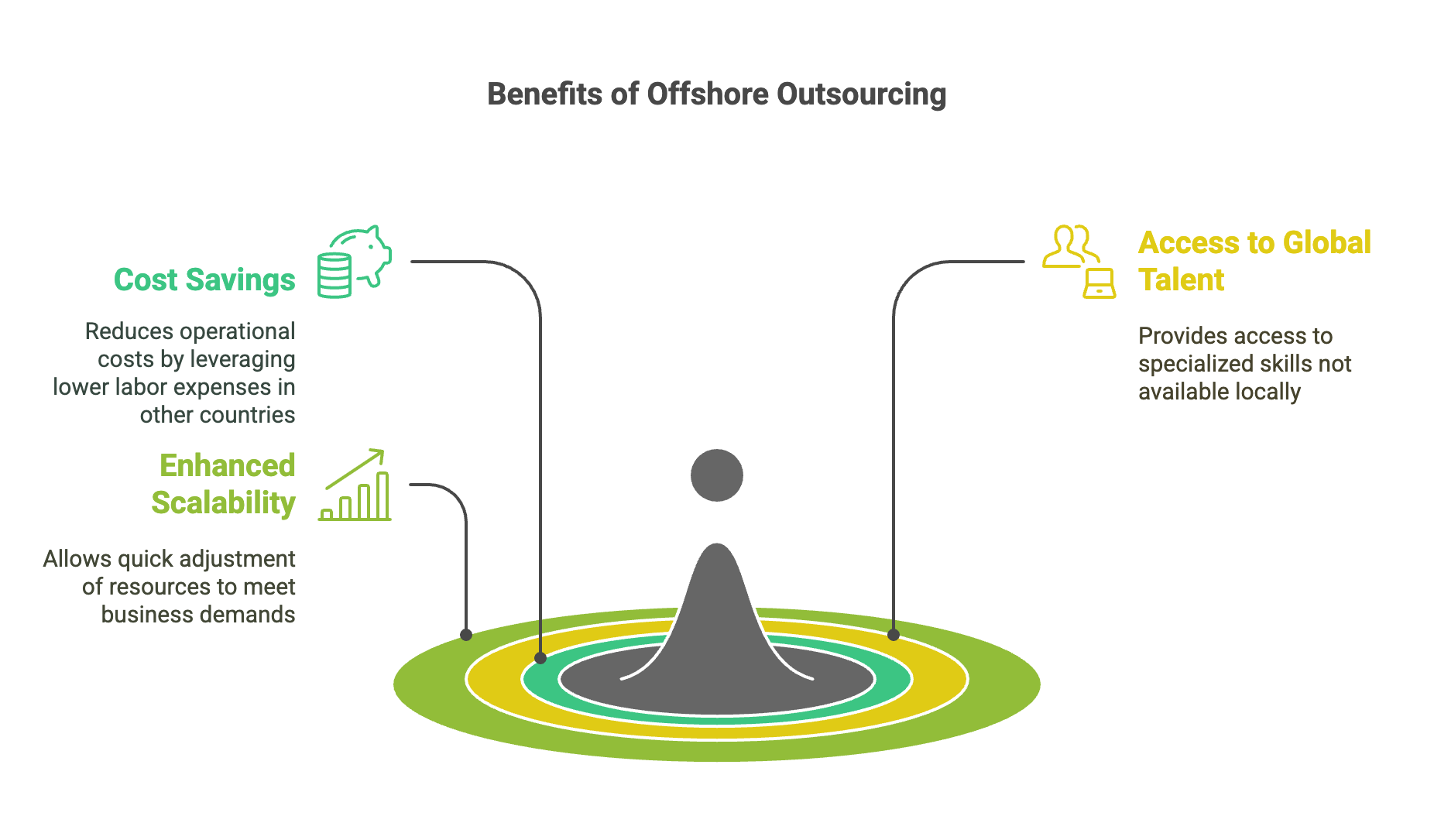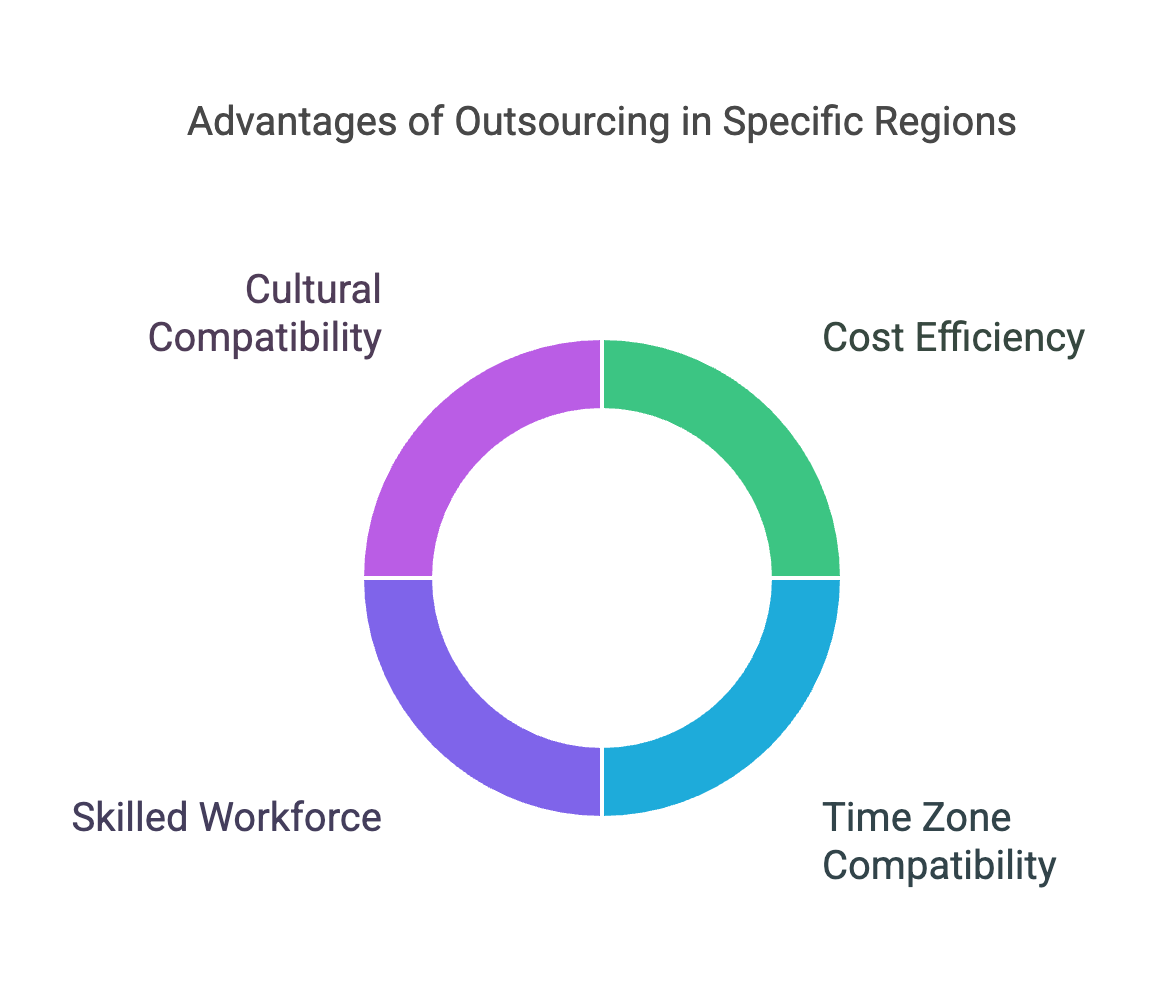Small to medium-sized businesses (SMBs) in the competitive U.S. market face various challenges that can significantly impact their operations and growth potential. These challenges are multifaceted, stemming from economic pressures, competition, and operational constraints.
Inflation is one of the major economic concerns for SMBs, with 37% of business owners reporting it as their biggest challenge, a percentage representing the highest level of concern in 40 years. Hiring and retaining qualified employees is another big challenge for small businesses, with over half of SMB owners reporting difficulties in meeting salary expectations due to competition from large organizations that offer more attractive compensation.
Offshore outsourcing can help small to medium-sized businesses lower costs from 20% to 50% compared to in-house hiring. By outsourcing non-core tasks, SMB owners can eliminate the need for office space and additional infrastructure, lowering costs even further. Outsourcing also provides access to global talent with specialized skills that may not be readily available domestically.
With Go Carpathian, you can outsource highly skilled talents from Eastern Europe, South Africa, and Latin America. Outsourcing in these regions allows you to reduce operational costs while leveraging the expertise of the local pre-vetted talents.
Are you considering learning about the advantages of offshore outsourcing? Contact us today to schedule a meeting with our recruiting specialist.
Streamlining business operations through cost efficiency and tapping into the global talent pool is an important strategic tool for small to medium-sized businesses. Another advantage of outsourcing is that it frees up resources for growth by allowing business owners to focus on core tasks and improving overall operational efficiency.
In this blog, we will explain the term offshore outsourcing, its benefits to SMBs, as well as the timeline of offshore hiring. We will also talk about the best ways to outsource in 2025 and we will share some advice that will help you get started with offshore outsourcing!
What is Offshore Outsourcing, and How Can It Benefit SMBs?
Offshore outsourcing refers to hiring external agencies in other countries to handle specific business functions instead of having them in-house. Offshore outsourcing allows companies to lower costs, access specialized skills, and focus on their core tasks.
Here’s how offshore outsourcing is different from onshore outsourcing:
Location: Offshore outsourcing refers to outsourcing services to other countries, often with significant time zone differences. On the other hand, domestic outsourcing refers to outsourcing work to third-party providers in the same country.
Cost: Unlike offshore outsourcing which generally offers lower labor costs, domestic outsourcing usually has higher costs due to operational expenses and local salary standards.
Cultural Differences: Offshore outsourcing may involve cultural differences and language barriers. One of the main benefits of domestic outsourcing is that cultural alignment and language fluency facilitate smoother interactions. However, offshore outsourcing doesn’t necessarily mean that cultural differences harm collaboration. With experienced outsourcing service providers like Go Carpathian, all candidates are screened for cultural fit.
What Is an Advantage of Offshore Outsourcing?
There are many advantages of offshore outsourcing that savvy business owners have been using for a long time. These benefits include reducing labor costs, tapping into the world of global talent, and improving scalability,
Cost Saving
Substantial cost reduction is one of the most important advantages of offshore outsourcing. In many offshore locations, labor costs are considerably lower than in the U.S. This allows SMBs to save on operational costs while keeping the quality of work.
With Go Carpathian, businesses can reduce labor costs by outsourcing work to Eastern Europe, South Africa, and Latin America. These locations are known for offering a high-quality workforce for lower costs when compared to the Western countries.
Access to Global Talent
Offshore outsourcing provides SMBs with access to a global pool of skilled talents that may not be available locally. Offshore locations have a wealth of expertise in areas such as IT, customer service, and marketing, which can be leveraged to enhance core business operations. By tapping into this global talent pool, SMBs can find the right skills for specific projects or ongoing tasks, ensuring high-quality outputs and innovation.
Enhanced Scalability
Scalability is another vital reason SMBs choose offshore outsourcing. As businesses grow or face changing demands, they often require additional resources quickly. Offshore outsourcing allows SMBs to scale their business operations up or down efficiently without the risks of hiring and training new employees domestically.
Businesses must maintain control and quality while outsourcing offshore work to ensure successful collaborations. Here are a few ways they can do it:
Clear Communication
Business owners must establish clear guidelines and quality standards from the beginning. Clear communication includes creating detailed job descriptions and expectations that align with the employee’s skill set. Many communication tools can help business owners enhance the interaction between in-house and outsourced teams. Here are some of them:
Video conferencing tools: Platforms like Zoom, Google Meet, and Microsoft Teams facilitate meetings and help business owners build relationships with contractors.
Project management tools: Tools like Trello, Asana, and Jira enable teams to work effectively, track progress, and take accountability for their work.
Instant messaging tools: Slack and Microsoft Teams are great tools for sharing real-time updates and queries.
Document-sharing tools: Dropbox and Google Drive ensure everyone has access to important information, which makes them effective tools for sharing documents.
To make the most of these tools, make sure you have regular meetings to facilitate seamless collaboration with your outsourced team.
Careful Talent Selection
Choosing the right outsourcing partner can be tricky if you don’t have a careful selection process in place. With Go Carpathian, you can be sure you will receive a list of pre-vetted candidates that suit your business needs. This way you can be sure you don’t lose money or time by hiring the wrong candidates.
Quality Control System
Once you gather a skilled outsourced team, you need to implement a robust quality control system that will help you keep track of progress and maintain the quality of your work. You can do this by establishing key performance indicators (KPIs) to measure success and by conducting regular audits to ensure that quality standards are being met. As a business owner, you can also leverage technology for real-time monitoring of outsourced teams:
WorkTime: This tool generates real-time reports for outsourced teams, showing productivity trends, application usage, and employee status.
Insightful: This screen monitoring program provides an analytics dashboard where you can see in real time what everyone is working on.
Konark Pro: The tool offers real-time productivity insights through a dashboard that allows evaluation of hour-by-hour output for outsourced teams.
Continuous Training and Development
Ensure your outsourced teams are up-to-date with the latest quality standards and practices by investing in ongoing training programs. This will also help you keep quality across in-house and outsourced operations.
What Is the Timeline of Hiring Offshore?
The timeline for hiring offshore talents typically involves several key steps and can vary depending on the complexity of the role and the efficiency of the recruitment process.
Here’s a general overview of the offshore outsourcing timeline:
Information gathering and CV sourcing: This step involves receiving the necessary information about the job requirements and sourcing CVs from potential candidates. This process usually takes less than one week.
Screening CVs: The next step is to screen the CVs to identify suitable candidates. This can take approximately 1 to 2 weeks, depending on the volume of applications and the specificity of the job requirements.
Setting up tests and interviews: Once suitable candidates are identified, tests and interviews are set up to further evaluate their skills and fit for the role. This phase typically lasts another 1 to 2 weeks.
Finalization and clarification: After interviews, any remaining questions or clarifications are addressed, and the final decision is made. This step usually takes less than one week.
Onboarding process: The onboarding process of offshore talents typically involves setting up necessary tools and software, conducting virtual training sessions, and integrating new talents into the company culture. Onboarding outsourced talents can be challenging because of limited personal interaction and cultural differences. Professional outsourcing providers like Go Carpathian offer ongoing support to ensure seamless onboarding of offshore hires.
When using an outsourcing agency like Go Carpathian, the process is typically faster because agencies have access to a large database of candidates and specialized teams that can quickly source and evaluate potential hires. This streamlined approach can reduce the hiring time to as little as a few weeks.
On the other hand, direct hiring offshore without an agency involves more steps, such as posting job descriptions, screening candidates, and conducting interviews, which can extend the hiring process to several weeks or even months. The agency’s expertise in navigating local employment laws and completing necessary paperwork also contributes to a quicker hiring process.
How to Choose the Right Offshoring Location
With Go Carpathian, you can choose the best locations for offshore outsourcing such as Latin America, South Africa, and Eastern Europe. These locations are considered great regions for outsourcing due to several key advantages.
Outsourcing in Latin America
Cost efficiency: Latin America offers significant cost reduction compared to North America and Europe, with hiring costs being 40-70% lower. This allows businesses to access high-quality talent at competitive rates.
Time zone compatibility: Latin America’s proximity to North America provides time zone alignment, facilitating real-time communication and collaboration. This is particularly beneficial for projects requiring ongoing interaction and immediate feedback.
Highly skilled workforce: Latin America has a large pool of highly skilled professionals, especially in IT and technology sectors, due to strong educational systems and investments in infrastructure.
Cultural compatibility: There are cultural similarities between Latin America and Western countries. This makes communication and collaboration easier.
Outsourcing in South Africa
Cost savings: South Africa offers competitive labor costs compared to Western countries, making it an attractive option for businesses looking to reduce operating expenses without compromising quality.
Time zone advantage: South Africa’s time zone is closer to Europe, allowing for better alignment with European business hours, which can facilitate smoother operations.
Skilled talents: The country has a well-educated workforce with expertise in various industries, including IT and customer service.
Outsourcing in Eastern Europe
Highly skilled hires: Eastern Europe is known for its highly educated workforce, particularly in technology and engineering fields.
Cost efficiency: Labor costs in Eastern Europe are generally lower than in Western Europe and North America, offering significant savings for businesses.
Cultural and language skills: Many Eastern Europeans are proficient in multiple languages, including English, which facilitates effective communication with Western clients.
The Top Advantages of Offshore Outsourcing for SMBs
Outsourcing offers SMBs a strategic advantage by providing access to skilled professionals at lowered costs, enabling them to compete effectively with larger companies. This approach allows SMBs to focus on core competencies while leveraging global expertise, thereby enhancing efficiency and driving business growth. By outsourcing non-core tasks, SMBs can reduce overhead expenses related to office space, utilities, and equipment, further enhancing financial benefits. Additionally, outsourcing provides flexibility and scalability, allowing businesses to adapt quickly to changing market demands.
1. How Offshoring Saves Costs with Improved Profit Margins
SMBs can significantly reduce overhead costs by outsourcing labor-intensive tasks such as customer support, data entry, and IT maintenance. Outsourcing these tasks allows SMBs to avoid the high costs associated with hiring and training in-house staff, as well as the expenses related to maintaining an in-house team, such as salaries, benefits, and office space. By outsourcing the workforce offshore, SMBs can access specialized skills and technology without the need for substantial capital investment, thereby reducing operational expenses. Additionally, outsourcing offers flexibility and scalability, enabling businesses to adjust their workforce according to demand without the fixed costs of full-time employees.
Outsourcing to key offshore destinations like India, the Philippines, and Eastern Europe can lead to significant cost savings for businesses. Here’s a breakdown of the average cost savings associated with outsourcing to these regions:
India Outsourcing Costs
Outsourcing to India can result in labor cost savings of up to 70% compared to hiring domestically in Western countries. The main reason for this is the lower wage expectations in India, which allows businesses to access skilled professionals at a fraction of the cost.
The Philippines Outsourcing Costs
The Philippines offers similar cost savings, with potential reductions in labor costs by up to 70%. This makes it an attractive destination for businesses looking to outsource tasks such as customer support and data entry.
Eastern Europe
Eastern Europe provides a highly skilled foreign workforce at competitive rates, often resulting in cost savings of up to 70% compared to Western Europe and North America. This region is particularly popular for IT and software development outsourcing due to its proximity and cultural similarities.
To help you understand the potential of outsourcing, we gathered a few real-life examples that illustrate how small businesses can effectively reduce costs by outsourcing non-core tasks:
Local Retailer with Knowledge Process Outsourcing (KPO)
A local retailer leveraged Knowledge Process Outsourcing (KPO) to analyze sales data, which transformed their marketing strategy and led to a 200% increase in sales. By outsourcing data analysis, the retailer was able to gain valuable insights without the need for in-house expertise, significantly reducing costs associated with hiring specialized staff.
Small Business with IT Outsourcing
A small business opted for IT outsourcing to manage its technology infrastructure. This decision allowed the company to save up to 40% on costs compared to maintaining an in-house IT team. Outsourcing enabled the business to access specialized IT services without bearing the expenses of recruitment, training, and infrastructure.
Small Business with Customer Service Outsourcing
Another small business outsourced its customer service operations to lower costs by 30-50%. By partnering with an offshore provider, the company was able to handle customer inquiries efficiently while avoiding the high costs of hiring and training local staff.
2. Access to Highly Skilled Talent Without the Overhead
There are many offshoring benefits, such as cost efficiency, scalability, flexibility, and cultural diversity. There are several ways businesses can scale their workforce quickly without hiring full-time, high-cost employees and they all include tapping into outsourcing:
Offshore outsourcing: Outsourcing specific tasks or entire departments to offshore hires can provide SMBs with access to specialized expertise that may not be available locally. This method can be particularly beneficial when facing tight deadlines or requiring skills that are scarce in the local market.
Staff augmentation: SMBs can add specialized hires to their existing teams without full-time hiring. This process is called staff augmentation. Augmented staff members are external professionals hired on a temporary or contract basis. By integrating augmented team members, businesses can control project management while benefiting from additional productivity.
Virtual staffing: Virtual staffing refers to the practice of hiring and managing remote employees who work from different locations using online communication tools. With virtual staffing, SMBs can access a broader range of expertise and abilities from overseas workers. This approach enables businesses to benefit from flexibility and scalability without significant overhead costs.
Outsourcing especially excels in industries such as IT development, digital marketing, design, and customer service.
3. How Hiring Offshore Helps You Maximize Core Business Functions
Outsourcing non-core functions such as administrative tasks, tech support, and manufacturing allows SMB owners to focus on strategic initiatives and growth by freeing up resources and enhancing operational efficiency.
Outsourcing non-core tasks can result in savings of up to 70% on salaries and benefits. This cost reduction allows SMBs to allocate more resources towards strategic growth and critical areas of the business. Besides money, outsourcing saves business owners time they can use to focus their attention on core business processes that drive innovation.
Here are some examples of the non-core tasks business owners can outsource to improve overall business performance:
Website Development
Outsourcing website development allows businesses to access specialized skills in design, coding, and digital marketing without the need for an in-house team. This can lead to faster project completion and higher-quality results.
Accounting
Outsourcing accounting tasks, such as bookkeeping, tax preparation, and financial analysis, can save businesses time and money. External accounting firms provide expertise in financial management, ensuring compliance and efficiency.
Supply Chain Management
Managing logistics and supply chain operations can be complex and resource-intensive. Outsourcing these tasks to specialized providers can streamline operations, lower costs, and improve delivery times.
Customer Service
Outsourcing customer service tasks, including phone support, live chat, and email inquiries, allows businesses to handle higher volumes of customer interactions efficiently. This can improve customer satisfaction and free up internal resources for other priorities.
IT Support and Management
Outsourcing IT support can help businesses manage network security, troubleshooting, and system updates without maintaining a full in-house IT department. This approach reduces downtime and ensures quick resolution of technical issues.
Marketing and Lead Generation
Outsourcing marketing efforts, including social media management and lead generation, can enhance brand visibility and attract new customers. External marketing agencies bring creative expertise and industry knowledge to these tasks.
Data Entry and Processing
Routine data entry tasks can be outsourced to maintain organized databases without diverting internal resources from more critical tasks.
Business owners who let offshore talents handle their operational, non-core tasks need to prioritize internal resources on innovation and customer acquisition. Here are several strategic approaches businesses can adopt:
Focus on core competencies: Concentrate internal resources on areas that drive innovation and customer acquisition, such as product development, marketing, and sales. This allows businesses to leverage their unique strengths and expertise to create competitive advantages.
Invest in human capital: Allocate resources to attract, retain, and develop skilled employees who can drive innovation and growth. This includes providing training, fostering a culture of innovation, and offering opportunities for professional development.
Leverage Technology: Utilize technological resources like software tools and platforms that support innovation and customer engagement. This can enhance productivity and enable more efficient use of internal resources.
4. How Outsourcing Helps Scalability – Grow Quickly and Efficiently
Outsourcing provides SMBs with the flexibility to scale their operations up or down in response to changing market conditions without the burden of long-term commitments or additional hiring costs. By partnering with offshore providers, SMBs can quickly adjust their workforce to meet fluctuating demand, adding or removing team members as needed. This approach eliminates the need for long-term contracts, allowing businesses to adapt rapidly to market changes without being tied to fixed agreements.
Furthermore, offshore outsourcing often involves pay-as-you-go models, where SMBs only pay for the productive hours worked by their offshore workforce, reducing financial risk and enabling effective cost management. This flexibility, combined with access to offshore talent employees, allows SMBs to focus on core business activities while leveraging external resources for operational agility, ultimately enhancing their ability to respond to market dynamics efficiently. Several SMBs have achieved faster growth through offshore outsourcing by expanding their production capabilities, increasing customer support hours, or launching new services. Here are some examples:
FinTech Company
A FinTech company outsourced its customer support operations to a team in Colombia. This move allowed the company to reduce expenses while maintaining high service quality, enabling it to respond more effectively to client inquiries and improve customer satisfaction.
US-Based Tech Startup
Another good example of successful offshore outsourcing is a tech startup that outsourced software development to an experienced team in Argentina. By leveraging the specialized knowledge of the Argentine team, the startup was able to deliver a high-quality product and meet strict development deadlines, thereby accelerating its growth and market presence.
eCommerce Business
An online retailer hired a virtual executive assistant from Brazil to handle administrative tasks such as emails and scheduling. This outsourcing decision increased overall efficiency and streamlined daily operations, allowing the business to focus on core competencies and drive growth without hiring additional internal staff.
How to Do Offshore Outsourcing the Right Way in 2025
In 2025, offshore outsourcing is poised to become an essential business strategy for seeking to enhance efficiency, lower costs, and access global hires. As companies navigate the complexities of a rapidly evolving market, understanding how to offshore outsource effectively is crucial for achieving sustainable growth and competitive advantage. There are some concerns around offshore outsourcing that many business owners have, such as ensuring quality control, communication barriers, and data security. Here’s how businesses can prevent and overcome these issues:
Ensuring Quality Control
When outsourcing offshore, SMBs often face concerns about maintaining the quality of work and results. To address these concerns and ensure high standards, SMBs can take several actionable steps:
Set clear expectations: Clearly define project goals, expected deliverables, timelines, and quality benchmarks before engaging offshore hires. This helps avoid ambiguity and aligns the offshore team’s focus with your expectations.
Rigorous outsourcing service provider selection: Conduct thorough due diligence and evaluation of potential outsourcing service providers. Assess their track record, expertise, and past client reviews to ensure they have a demonstrated history of delivering high-quality work.
Implement strict quality controls: Embed quality control measures throughout the project lifecycle. Conduct regular checks, audits, and milestone evaluations to ensure that the work adheres to agreed-upon quality standards.
Robust communication channels: Foster open communication channels with the offshore team using various collaboration tools for discussions, feedback, and prompt issue resolution. Clear and consistent communication is vital to ensure alignment with quality expectations.
Regular performance reviews: Conduct periodic performance reviews to evaluate the offshore team’s performance against predetermined benchmarks. This allows for recognition of achievements and proactive resolution of any shortcomings.
Continuous training and support: Provide ongoing training and resources to enhance the offshore team’s capabilities. Ensure they have access to tools and knowledge necessary for meeting quality standards.
Bridging Communication Gaps
Offshore outsourcing presents several communication challenges, such as time zone differences and language barriers, which can hinder effective collaboration. Here are some common issues and solutions to streamline communication:
Common Communication Issues
Time zone differences: Teams located in different time zones may struggle to coordinate meetings and tasks, leading to potential delays and miscommunication.
Language barriers: Differences in language proficiency can result in misunderstandings and misinterpretations, affecting the quality of communication and project outcomes.
Cultural differences: Variations in cultural norms and work practices can lead to misunderstandings and conflicts, impacting team cohesion and productivity.
Lack of face-to-face interaction: The absence of in-person communication can reduce personal connections and lead to communication breakdowns.
Solutions to Streamline Collaboration
Use communication tools: Implement tools like Slack and Zoom for real-time communication and collaboration. These platforms facilitate instant messaging, video calls, and file sharing, bridging the gap between teams across different locations.
Project management software: Use project management tools such as Asana or Trello to track progress, assign tasks, and set deadlines. These tools help maintain transparency and ensure everyone is aligned with project goals.
Establish clear communication: Define clear communication channels and protocols early on. This includes setting regular check-ins, status updates, and a primary point of contact to ensure consistent communication.
Cultural sensitivity training: Provide training to enhance cultural awareness and sensitivity among team members. This helps in understanding different work cultures and communication styles, reducing potential conflicts.
Language training: Offer language training to improve fluency and proficiency among team members. This can help reduce language barriers and enhance overall communication effectiveness.
Data Security and Confidentiality
Protecting sensitive business information when outsourcing is crucial to safeguarding confidentiality, preventing data breaches, and maintaining operational integrity.
Best practices for ensuring security include implementing end-to-end encryption for data in transit and at rest, establishing strict access controls with multi-factor authentication, and conducting regular audits to ensure compliance with data protection regulations like the General Data Protection Regulation (GDPR).
Additionally, using non-disclosure agreements (NDAs) and service level agreements (SLAs) helps enforce confidentiality and define performance standards. Regular training for staff on confidentiality measures and maintaining secure communication channels further improves data security.
How SMBs Can Get Started with Offshore Outsourcing
By outsourcing non-core functions, SMBs can focus on innovation and customer acquisition while leveraging external expertise for operational tasks. Here’s how SMBs can start their process of offshore outsourcing and finally focus on growth and innovation:
Assessing Your Business Needs
Begin by identifying tasks that are not central to your business organization. Often, these tasks include administrative support, IT maintenance, and customer service. Repetitive tasks such as data entry and bookkeeping are also very time-consuming. Outsourcing these tasks can free up your internal resources that you can allocate to more strategic activities.
Finding the Right Offshore Partners
To find the right offshore talents, SMBs can hire professional outsourcing agencies like Go Carpathian. As an experienced outsourcing service provider, Go Carpathian can connect business owners to previously vetted candidates that match their specific needs.
Pre-vetting candidates is especially important because it saves business owners time and ensures that they only talk to people who get their work. Finding the right talent can be an overwhelming business process and hiring a professional agency can help you get in touch with the right people.
Another way to look for talent is to check reputation and testimonials. Awards and certifications can also provide additional assurance of their credibility and expertise. Engage in detailed interviews with potential partners to understand their communication style, project management approach, and cultural compatibility. This helps ensure alignment with your business values and operational needs.
Setting Clear Expectations and KPIs
Setting clear performance metrics and expectations upfront is crucial for ensuring that the outsourcing partnerships align with business goals. When you think about clear expectations, think about key performance indicators (KPIs) you should track from the beginning, such as response times, quality of work, customer satisfaction, and cost savings.
How to Hire the Right Talent (Offshore or Local)
To identify the type of offshore employees they truly need, SMBs should begin by evaluating their current business objectives and identifying any gaps. Clearly outline the roles and responsibilities for each position. This includes specifying the skills, experience, and qualifications required to ensure clarity in your hiring process. Furthermore, performing a skills audit of the existing team to identify current strengths and weaknesses helps pinpoint areas where additional talent is needed.
Aligning talent needs with business goals is crucial for achieving strategic objectives and driving organizational success. When talent is aligned with business goals, companies can effectively scale offshore operations and enhance technology capabilities, leading to improved efficiency and innovation.
In crafting effective job descriptions to attract the right candidates, SMBs should focus on several key elements. Outlining the key responsibilities of the role, and detailing specific tasks and expectations to ensure candidates understand their potential duties should be the first step. Stating qualifications are required, including necessary skills, experience, and education, to attract candidates who meet the job’s demands comes next. Additionally, highlighting the company culture by describing the work environment, values, and mission helps candidates assess their fit within the organization.
We finally arrived at conducting the right interviews. To conduct interviews that assess both technical skills and cultural fit, SMBs should use a combination of technical questions to evaluate expertise and behavioral questions to gauge alignment with company values, ensuring candidates demonstrate the necessary skills and share the organization’s ethos.
SMBs can utilize tools like Zoom or Microsoft Teams for video calls with remote workers. Also, they can incorporate technical assessments using platforms such as HackerRank or Codility, and assign trial projects to evaluate practical skills and cultural fit.
To thoroughly evaluate remote candidates, SMBs can use a combination of skills tests to assess technical abilities, reference checks to verify past performance, and portfolio reviews to examine previous work quality, ensuring a comprehensive assessment of both skills and cultural fit. A solid onboarding process is crucial for remote or offshore hires, as it ensures they integrate smoothly into the team by providing clear communication, comprehensive training, and a welcoming environment that aligns them with company culture and expectations.
To retain both offshore and local talent, SMBs can implement strategies such as offering competitive pay and benefits, fostering a positive work culture that values diversity and inclusion, and providing growth opportunities through training and career development programs. Retaining skilled remote employees contributes to long-term business growth and stability by ensuring continuity of expertise, enhancing team cohesion, and reducing recruitment costs, ultimately leading to improved productivity and innovation.
Thinking of hiring an Outsourcing Provider?
Offshore outsourcing offers small and medium-sized businesses (SMBs) key benefits such as cost efficiency, access to top global talent, scalability to adapt to changing demands, and operational flexibility to focus on core competencies while managing non-core functions effectively.
SMB owners should consider offshore outsourcing as a strategic approach to optimize operations, access specialized skills, and drive growth by leveraging cost-effective resources and flexible work arrangements.
Schedule a Discovery Call to learn more about how outsourcing can benefit your specific business needs!








